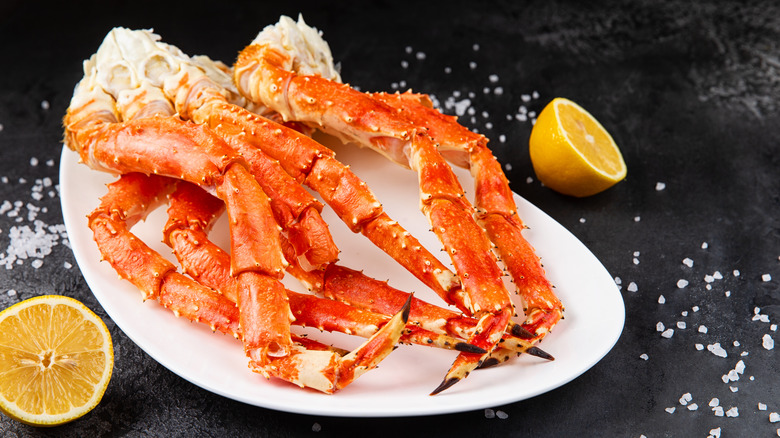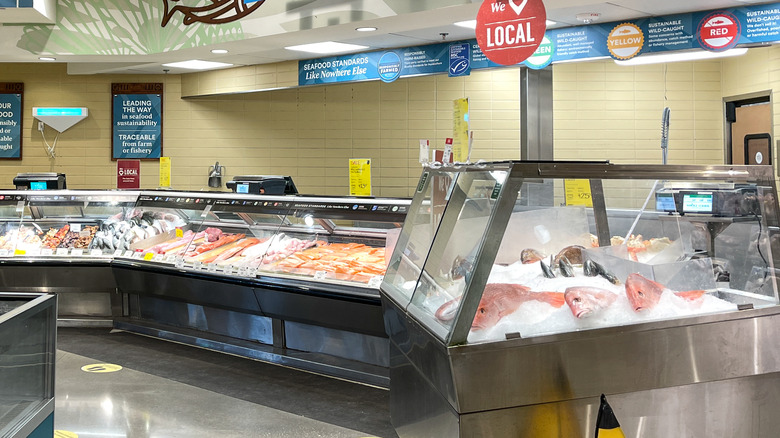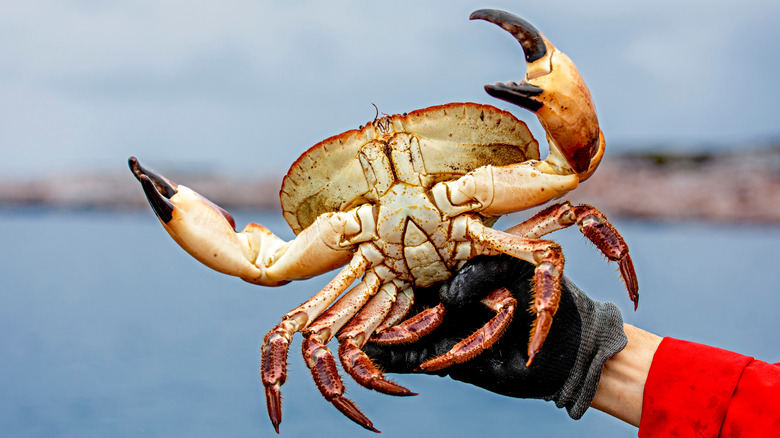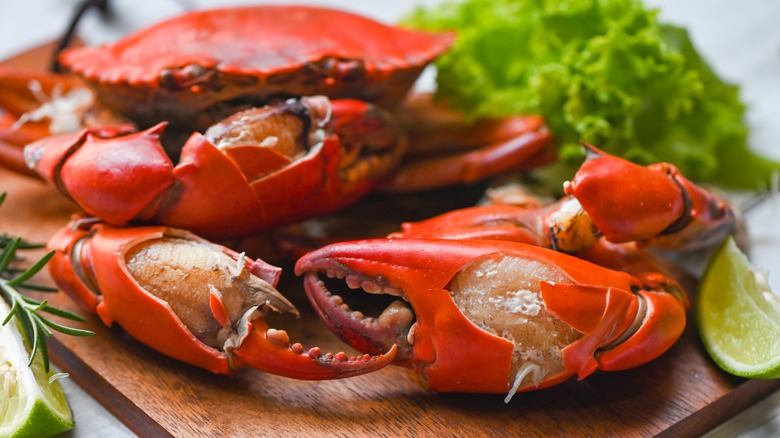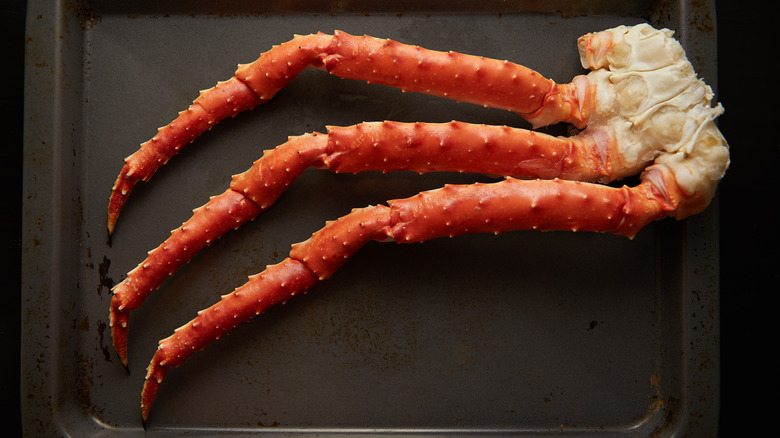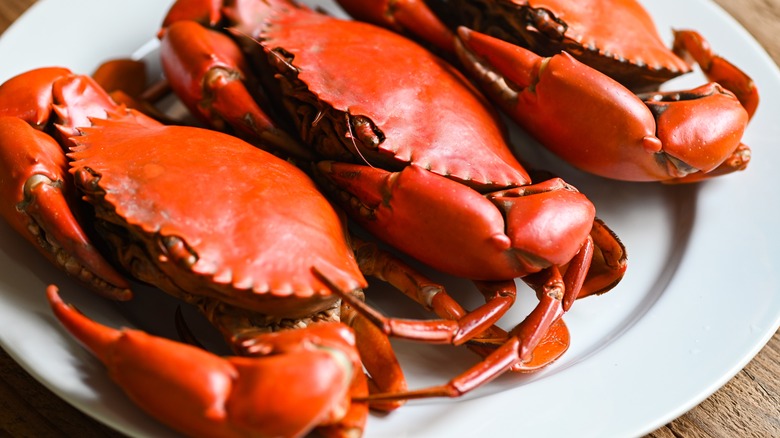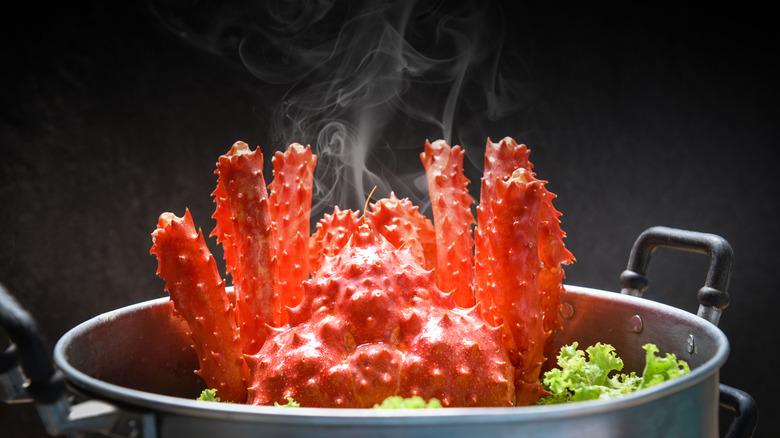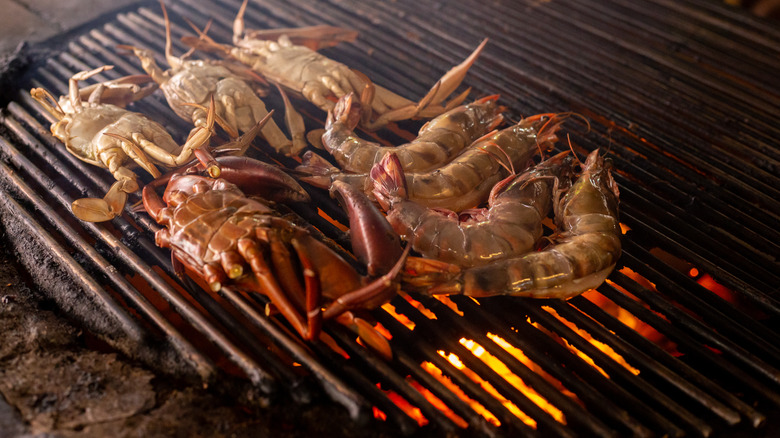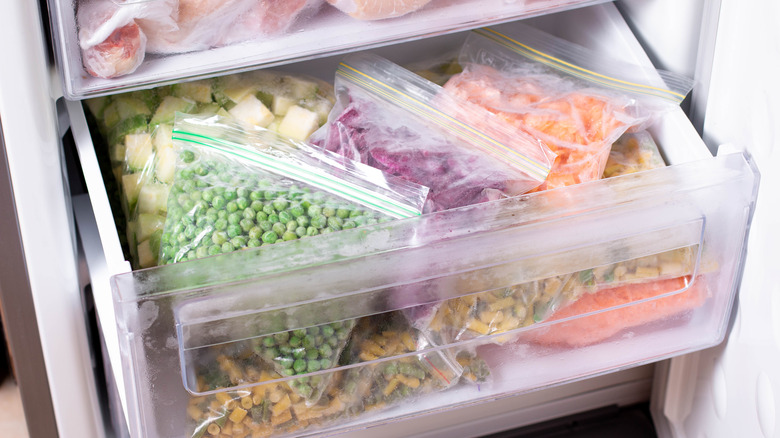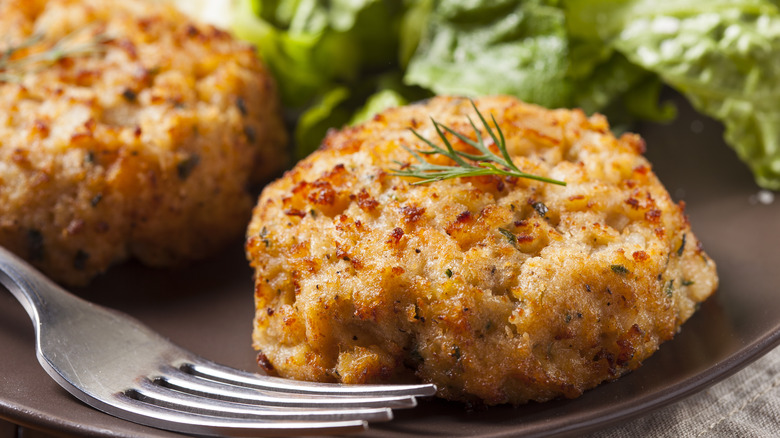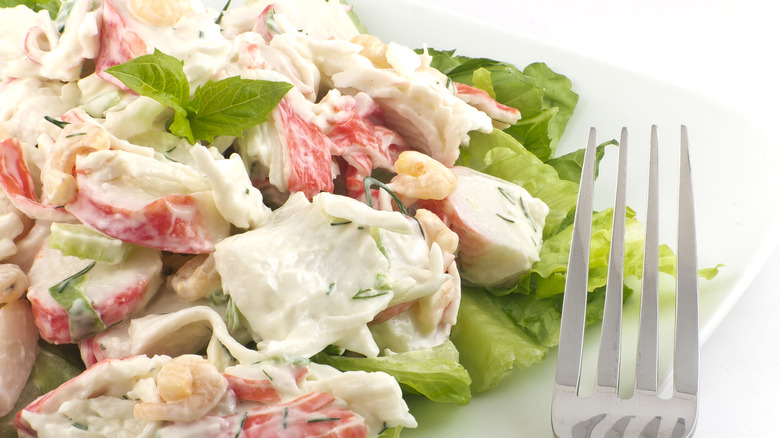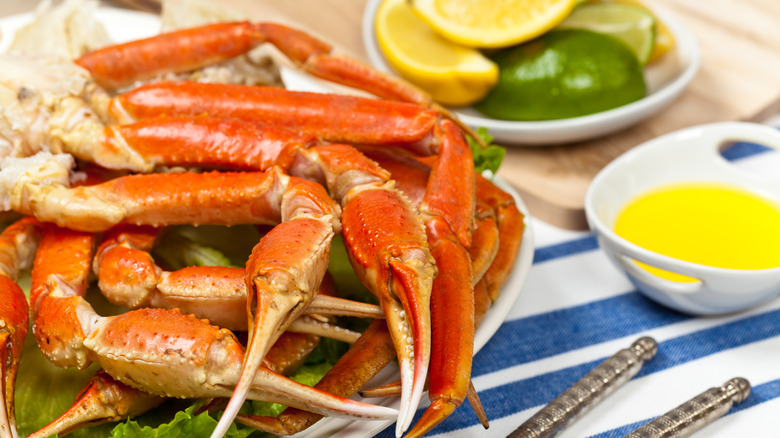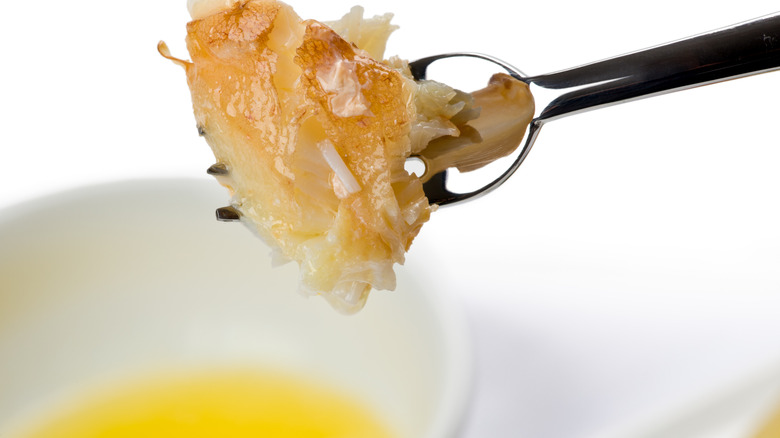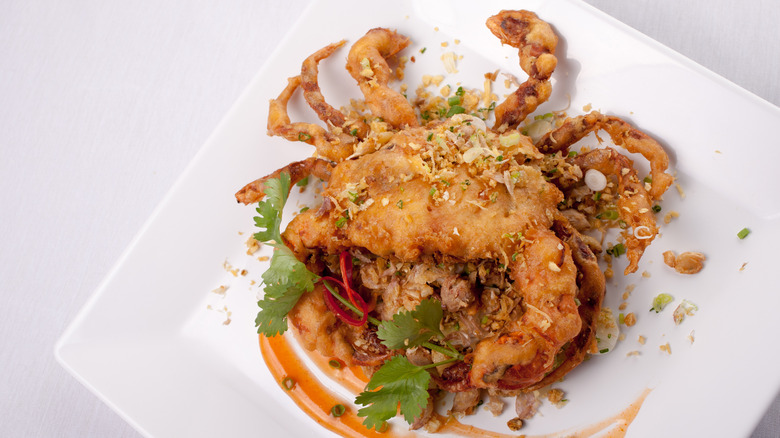The 14 Biggest Mistakes You're Making When Cooking Crab
If you're trying to cook crab legs at home, it's easy to make mistakes. However it's prepared, crab is one of the greatest indulgences in life: Succulent crab legs dipped in melted butter. Tender crab cakes tucked into a bun. Crisp soft-shell crab coated in flaky tempura batter.
We spoke with two seafood experts to get the lowdown for folks cooking with crab, such as how to avoid or remedy common mistakes. Bill Nevruz is executive partner at Shaw's Crab House in Chicago, which features crab throughout the menu, including the menu's two most popular items: Maryland-style crab cakes and red king crab legs with drawn butter. The restaurant has two locations in Chicagoland and orders more than 30,000 pounds of crab each year.
We also spoke with Jason Hedlund, who has worked in the retail seafood industry for 24 years and is the principal global seafood buyer for Whole Foods Market. The Amazon-owned chain carries year-round crab, such as previously frozen clusters of king, snow, and Dungeness crab, as well as seasonal and local items like blue crab, blue swimming crab picked meats, and whole-cooked Dungeness crab. We asked for advice right from the experts: there's no need to head to the coast to enjoy great-tasting crab dishes if you avoid these common mistakes.
Not knowing how to select crab at the fish market
One of the biggest mistakes people make when cooking with crab is not knowing how to choose quality seafood. Shop at a market you can trust where the displays and counters are kept clean and well-maintained. "You can check for quality a few ways," says Hedlund of Whole Foods Market. "You can use your nose, and avoid anything that smells 'off' or has ammonia odors. You can also look at color and avoid 'graying' meat. For previously frozen crab avoid signs of dehydration or freezer burn. Look for exposed meat to be nice and white with some reddish and orange, as well as bright and clean shell coloration."
If you get the chance when buying and cooking crabs, choose live crabs and pay attention to what's in season. Blue crabs are typically in season from April through December in the mid-Atlantic region, while Dungeness crabs are harvested between December and July. And stone crabs are harvested in Florida from mid-October through May. Unless they're sold live, seafood counters generally sell already cooked and often were previously frozen crabs.
"When seasonally available, fresh offerings will typically be sweeter and moister than the same crab offering as previously frozen," says Hedlund. "However, the benefit of frozen or previously frozen is being able to still enjoy your favorite type of crab when the season is up or if you're on the opposite coast of an in-season variety."
Ignoring sustainability when buying crab
Like many types of seafood, overfishing and practices that damage the environment are factors in crab fishing. In fact, Alaska canceled snow crab season in 2022 because of dwindling populations. It's the first time winter snow crab season has been canceled in Alaska, reports the Washington Post.
While we should all do our part to try to minimize humankind's impact on the oceans, including patronizing companies that are minimizing the use of excessive plastic, we can also make sure that we're being smart with where we spend our seafood shopping dollars. Source your crab from a reputable retailer that stocks products that are Marine Stewardship Council Certified, and check the Monterey Bay Aquarium Seafood Watch Guide to see what species and origins are the most sustainable options.
Currently, the Monterey Bay Aquarium Seafood Watch shows some of the best crab choices including blue king crab from the Bering Sea, red king crab from Norway or Alaska, blue crab from Maryland, golden king crab from Alaska, and Southern tanner crab from Alaska. "All of the crab in our seafood department — and or in our prepared foods department — must meet these standards for sustainability," says Hedlund.
Being unfamiliar with the different types of crabs
According to Brittanica, there are as many as 10,000 species of crabs in existence but, of course, of that myriad variety only a handful are actually eaten by humans.
Dungeness, king crabs, snow crabs, and blue crabs are all different species that can be found on menus and in seafood. Maryland blue crabs are meaty with a touch of sweetness and are versatile: you can eat them right out of the shell or use their meat in crab cakes or dips. Soft-shell crabs, which are actually just-molted blue crabs, are eaten whole, often sauteed or breaded and fried, and their tender new shells are soft enough to be eaten. Dungeness crabs are a staple of the West Coast — you'll find them on menus all over San Francisco.
Snow crab and the more luxurious King crab are likely what you're picturing when you think of crab legs. The long shells can be cracked to pull out a long morsel of tender meat, best enjoyed dipped in drawn butter. And stone crab claws, which some consider more sustainable as the claws are removed and crabs returned to the ocean where they can grow a new appendage, can be found in seafood shacks throughout Florida. Ordered up by the buckets, they're often dumped on a paper-covered table for folks to crack open and extract the prized meat from inside.
Cooking crab in the oven
Unless you're cooking live crabs, chances are the crab you're preparing has already been cooked, so really it's just a matter of heating the crabs up again so they'll be ready to eat. There are many ways of doing this, but some chefs advise against using the oven. "I would ... avoid baking or roasting," says Nevruz of Shaw's Crab House. "It takes too long and usually dries out the meat."
If you do want to use the oven, though, opt for either a high-heat method or one that incorporates steam. You can broil the crab for a few moments until it's warmed through (brush with a little butter first to prevent it from drying out). To steam, place the crab in a baking dish with an inch or so of water in it, and cover the whole thing with aluminum foil, poking some holes in the foil to allow a little steam to escape. It only takes five to eight minutes to heat the crabmeat through. This is a good method to use if you're cooking up crab legs for a crowd since the baking pans will hold a lot.
Overcooking crab
Delicate crab meat can quickly turn tough and unappealing if it's overcooked. If you're starting with already cooked crab that you're reheating, heat it just until it's warmed through, so you'll preserve the tender meat. "Home cooks tend to overcook crab, I think," says Nevruz of Shaw's Crab House. "It's very delicate and doesn't really stand up to overcooking."
Hedlund agrees: "When reheating, it should only be cooked enough to warm through as the texture can suffer and become dry or dehydrated if overcooked."
Even cooking raw crabs doesn't take too long. And if you do boil fresh crab, you'll get the chance to witness a phenomenon of even the dingiest brown crab will turn bright red or orange when it's done cooking. It's because crabs contain a highly pigmented protein that's released when the crabs get hot. Watch for this as a sign that your crabs are done cooking, so you can take them off the heat before they overcook.
Not steaming crab legs
This gentle heating method is one of the best cooking methods to ensure that the crabmeat stays moist and tender. You can add lemon, white wine, beer, herbs, and other flavorings to the cooking liquid to add subtle flavor, but it's not necessary.
Making steamed crab legs is easy: In a Dutch oven or other deep pot, heat your cooking liquid until it's simmering. Set a steaming basket over the liquid. Add the crab legs, cover the pot, and cook for five to seven minutes, or until the crabs are heated through (you can crack open one of the legs to see if the meat is hot or if there's steam inside).
Not only is steaming a forgiving preparation for heating up pre-cooked crab, but it is great for preparing large batches of crab, and holding the crab inside the steamy pot with the burner turned off, can also help keep it hot for a period of time until you're ready to eat it.
Overlooking grilling when cooking crab
Turning to your gas or electric grill is another way to cook or heat crabs that's not to be overlooked. "Grilling on high heat can also be very nice," agrees Nevruz. Heating crab legs on a hot grill only takes about 10 minutes and will give the crabs a smoky taste. You just need to make sure to only grill them until they're heated through to avoid overcooking, and it's best to heat them on indirect heat, rather than directly over the flame. You can also wrap clusters of crab legs in aluminum foil to prevent them from drying out.
Using the grill to make a whole feast centered around the crab is a fun and easy way to make a meal. Along with the crab, try grilling up corn on the cob, halved new potatoes, and some andouille sausages for a grilled version of a crab boil recipe. A generous dusting of Cajun spice mix over everything will add to the Louisiana flair of the feast. Don't forget to melt butter on the side burner for dipping.
Grilling works great for rock crab, snow or king crab legs, and Dungeness crabs.
Cooking crab while it's still frozen
By the time the crab you're buying has reached your supermarket, it's likely been cooked and then flash-frozen so that it'll taste fresh. However, for the best results, make sure to thaw the crab before you cook it. Hedlund of Whole Foods offers this advice for handling frozen crab: "Slow thaw under refrigeration and then high heat methods until just warmed through. You can steam, broil, or even grill, but just until warmed."
The Alaskan King Crab Co., which ships crab overnight to home cooks, recommends removing vacuum-sealed packaging and thawing frozen crab in the refrigerator overnight. Defrosting your seafood on the counter, in the microwave, or submerging it in hot water are all no-nos, as they could cause bacteria growth and will negatively impact the texture and flavor.
Once the crab is completely thawed, it's ready to prepare with your favorite recipe or cooking method — just be sure to eat the crab dish within three to five days and throw it out if it develops an "off" odor or a slimy texture.
Overlooking lump crab meat as an easy option
When you buy lump crab meat — as opposed to crab legs or whole crabs — all the work's done for you. Cleaned, shelled, and in bite-sized chunks, it usually comes pasteurized and in a tub in your refrigerator section, and can also be found in a shelf-stable can. Canned crab meat is great to have on hand for a last-minute crab pasta craving, but it may taste saltier and not as fresh since it's undergone pasteurizing and the canning process.
Lump crab meat is a favorite with chef Ina Garten, because it's ready to eat and easy to incorporate into recipes. Lump crab meat, or "picked meat" is usually from the blue crab or blue swimming crab, and is the best option for recipes like crab cakes, dips, or pasta, says Hedlund.
Be sure to know the different types of picked crab meat, though, and what they're best for. "The Jumbo Lump pieces should be used for recipes with gentle handling and limited mixing to avoid breaking up the premium pieces," says Hedlund. "Lump is composed of smaller pieces and is ideal for recipes where you want to utilize the sweeter body meat, but will be working the product into items like cakes and pasta. Claw meat is ideal for full-flavored recipes that can use pieces of a finer texture like dips and spreads."
Not having the right tools to eat crab legs and claws
You sit down to dinner, and a pile of bright-red crab legs is set before you, their hard, spiky shells the barrier between you and the succulent meat inside. Now what? Patience and "a simple cocktail fork is all you really need," says Nevruz. We think a claw cracker can help as well, or a wooden mallet to crack the hard shells if you're eating Maryland crabs.
To crack crab legs, Alaskan King Crab Co. recommends separating the legs from the cluster and the claw, then breaking the pieces apart at the joint. Use your thumbs to gently crack the long piece in the middle, and then carefully peel the shell away, or bend the legs slightly back and forth until the shell breaks in half, leaving the long piece of meat intact, and carefully pulled out in one piece. Use a claw cracker to break open the hard claw, and the cocktail fork to extract the meat from the claw, the knuckles, and the other parts of the crab.
There's an art to eating whole blue crabs as well. All it takes is a knife, a cocktail fork, and your fingers to take apart the crab and fish out every little morsel of meat within.
Using a spoon to mix lump crab meat recipes
If you're spending a premium for lump crab meat, especially the Jumbo Lump variety, you want to preserve that tender texture and big chunks. "Never mix your recipe with a spoon," advises Nevruz. "Use your hands to fold the recipe, it helps keep the meat from becoming minced and mushy."
By tenderly folding and combining with clean hands, you can keep pieces intact, which will make for a better texture and appearance for crab salad, crab cakes, or crab filling for appetizers. Similar caution should be taken when preparing crab cakes, which fall apart very easily, especially if there's more crab meat than there is binding — the true sign of a good-quality crab cake! Besides being super-gentle with the mixture, chilling the formed crab cakes in the fridge before frying will help keep the mixture together, so they won't fall apart when you flip them over in the pan.
Getting overcomplicated with crab recipes
Our experts agree: the best way to enjoy the rich, mildly sweet flavor of crab meat is by keeping it uncomplicated. "I keep it simple and let the sweetness of the crab shine. Butter, lemon, parsley and garlic are traditional accompaniments and in my opinion are hard to beat," says Hedlund. Nevruz's favorite preparation is similar: "Classic steamed crab legs served with melted butter, lemon and a bit of hot sauce. A great bottle of buttery Chardonnay and I'm all set!" he says.
If you do want to get creative, there are plenty of untraditional recipes that incorporate crab in unexpected combinations. Hedlund recommends experimenting with your recipes, such as king crab legs with spicy garlic oil, crab and mango toasties, and grilled heirloom tomato soup with crab.
While complicated preparations can be a fun undertaking for a dinner party, there's also something to be said for serving up crab the way crab shacks and seafood restaurants worldwide do: steamed and served with drawn butter, a squeeze of lemon, and not much else. A dusting of Old Bay seasoning can be a nice touch but many seafood fans often prefer to let the luxurious flavor of crabmeat stand on its own.
Using cheap butter for dipping
When you're serving crab the most simple and traditional way, it's absolutely essential to make sure each ingredient is top-quality. That means springing for better-quality butter, rather than the cheap generic version you might buy for everyday use. Try one of the foil-wrapped European-style butter brands, such as Plugra, or one of the other fancy butters that can often be found in specialty markets for a rich flavor.
"I like to use a high-quality salted butter and just melt slowly," says Nevruz. Drawn butter might sound fancy on the menu of your favorite seafood menu, but it's really just chef-speak for melted butter. Some chefs prefer to use clarified butter — butter that's been simmered until its milkfat separates and can be removed — as drawn butter.
Because it is pure butterfat, clarified butter has a more neutral flavor, which not everyone favors. "Some prefer the drawn butter which takes out some of the milk fat. For me the natural 'buttery' flavor of just melted butter is what I'm looking for," says Nevruz.
Missing out on soft-shell crab season
Soft-shell crabs are blue crabs that have molted but haven't yet grown their hard exoskeleton. Because of this, they can be eaten whole, shell and all. They're harvested in a short window in the spring and are a delicacy that seafood lovers wait for with anticipation.
Nevruz at Shaw's shares his favorite preparation for soft-shell crabs: "Gently pan sauté your soft shell with a light dusting of flour for a crispy delicate dish or tempura fry and serve with simple ponzu sauce," he says.
We also love these tender crabs dredged in cornmeal and Old Bay seasoning and fried in butter or rolled up into a spider roll at our favorite sushi restaurant. Chinese restaurants will often feature salt and pepper soft-shell crabs on menus in the spring, and seafood joints will serve them up deep-fried and sandwiched in a bun. However they're prepared, soft-shell crabs are a seasonal treat that's not to be missed.
